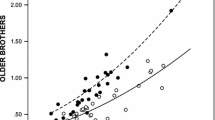Abstract
Studies have established that having older brothers is associated with an increased incidence of male homosexuality. This so-called fraternal birth order effect has been found in different times and cultural settings. The current study attempted to examine whether this effect was present in the Greek cultural context and whether it could also predict bisexuality or heterosexuality with occasional same-sex attractions. On the basis of an online sample of 1617 Greek-speaking participants, it was found that, for men, a higher number of older brothers were associated with an increased probability to be homosexual, but it had no effect on the probability to be bisexual or heterosexual with same-sex attractions. In women, the number of older brothers had not any effect on sexual orientation.
Similar content being viewed by others
References
Apostolou, M. (2013). Interfamily conflict, reproductive success, and the evolution of male homosexuality. Review of General Psychology,17, 288–296.
Bell, A. P., Weinberg, M. S., & Hammersmith, S. K. (1981). Sexual preference: Its development in men and women. Bloomington: Indiana University Press.
Blanchard, R. (2001). Fraternal birth order and the maternal immune hypothesis of male homosexuality. Hormones and Behavior,40, 105–114.
Blanchard, R. (2018a). Fraternal birth order, family size, and male homosexuality: Meta-analysis of studies spanning 25 years. Archives of Sexual Behavior,47, 1–15.
Blanchard, R. (2018b). Response to commentaries: Meta-analysis of probability samples and other new evidence. Archives of Sexual Behavior,47, 49–57.
Blanchard, R. (2018c). Older brothers and older sisters odds ratios in 36 samples of homosexual males [Letter to the Editor]. Archives of Sexual Behavior,47, 829–832.
Blanchard, R., & Bogaert, A. F. (1996a). Biodemographic comparisons of homosexual and heterosexual men in the Kinsey interview data. Archives of Sexual Behavior,25, 551–579.
Blanchard, R., & Bogaert, A. F. (1996b). Homosexuality in men and number of older brothers. American Journal of Psychiatry,153, 27–31.
Blanchard, R., & Bogaert, A. F. (2004). Proportion of homosexual men who owe their sexual orientation to fraternal birth order: An estimate based on two national probability samples. American Journal of Human Biology,16, 151–157.
Blanchard, R., & Lippa, R. A. (2007). Birth order, sibling sex ratio, handedness, and sexual orientation of male and female participants in a BBC internet research project. Archives of Sexual Behavior,36, 163–176.
Blanchard, R., & Zucker, K. J. (1994). Reanalysis of Bell, Weinberg, and Hammersmith’s data on birth order, sibling sex ratio, and parental age in homosexual men. American Journal of Psychiatry,151, 1375–1376.
Blanchard, R., Zucker, K. J., Siegelman, M., Dickey, R., & Klassen, P. (1998). The relation of birth order to sexual orientation in men and women. Journal of Biosocial Science,30, 511–519.
Bogaert, A. F. (1998). Birth order and sibling sex ratio in homosexual and heterosexual non-white men. Archives of Sexual Behavior,27, 467–473.
Bogaert, A. F. (2003). Interaction of older brothers and sex-typing in the prediction of sexual orientation in men. Archives of Sexual Behavior,32, 129–134.
Bogaert, A. F. (2006). Biological versus nonbiological older brothers and men’s sexual orientation. Proceedings of the National Academy of Sciences of the USA,103, 10771–10774.
Bogaert, A. F., Skorska, M. N., Wang, C., Gabrie, J., MacNeil, A. J., Hoffarth, M. R., … Blanchard, R. (2017). Male homosexuality and maternal immune responsivity to the Y-linked protein NLGN4Y. Proceedings of the National Academy of Sciences of the United States of America,115, 302–306.
Camperio-Ciani, A., Corna, F., & Capiluppi, C. (2004). Evidence for maternally inherited factors favoring male homosexuality and promoting female fecundity. Proceedings of the Royal Society of London, Series B: Biological Sciences,271, 2217–2221.
Cantor, J. M., Blanchard, R., Paterson, A. D., & Bogaert, A. F. (2002). How many gay men owe their sexual orientation to fraternal birth order? Archives of Sexual Behavior,31, 63–71.
Ellis, L., & Blanchard, R. (2001). Birth order, sibling sex ratio, and maternal miscarriages in homosexual and heterosexual men and women. Personality and Individual Differences,30, 543–552.
Hare, E. H., & Moran, P. A. P. (1979). Parental age and birth order in homosexual patients: A replication of Slater’s study. British Journal of Psychiatry,134, 178–182.
King, M., Green, J., Osborn, D. P. J., Arkell, J., Hetherton, J., & Pereira, E. (2005). Family size in White gay and heterosexual men. Archives of Sexual Behavior,34, 117–122.
LeVay, S. (2010). Gay, straight, and the reason why: The science of sexual orientation. Oxford: Oxford University Press.
Li, G., & Wong, W. I. (2018). Single-sex schooling: Friendships, dating, and sexual orientation. Archives of Sexual Behavior,47, 1025–1039.
Rahman, Q., Clarke, K., & Morera, T. (2009). Hair whorl direction and sexual orientation in human males. Behavioral Neuroscience,123, 252–256.
Savin-Williams, R. C., Joyner, K., & Rieger, G. (2012). Prevalence and stability of self-reported sexual orientation identity during young adulthood. Archives of Sexual Behavior,41, 103–110.
Schwartz, G., Kim, R. M., Kolundzija, A. B., Rieger, G., & Sanders, A. R. (2010). Biodemographic and physical correlates of sexual orientation in men. Archives of Sexual Behavior,39, 93–109.
Slater, E. (1962). Birth order and maternal age of homosexuals. Lancet,1, 69–71.
Wampold, C. H. (2018). The association between fraternal birth order and anal-erotic roles of men who have sex with men. Archives of Sexual Behavior,47, 2445–2454.
Yougov Report. (2015). Retrieved July 6, 2016, from https://d25d2506sfb94s.cloudfront.net/cumulus_uploads/document/isqcugzp6d/tabs_OPI_Kinsey_Scale_20150813.pdf.
Author information
Authors and Affiliations
Corresponding author
Additional information
Publisher's Note
Springer Nature remains neutral with regard to jurisdictional claims in published maps and institutional affiliations.
Rights and permissions
About this article
Cite this article
Apostolou, M. Does Fraternal Birth Order Predict Male Homosexuality, Bisexuality, and Heterosexual Orientation with Same-Sex Attraction? Evidence from a Greek-Speaking Sample from Greece. Arch Sex Behav 49, 575–579 (2020). https://doi.org/10.1007/s10508-019-01466-3
Received:
Revised:
Accepted:
Published:
Issue Date:
DOI: https://doi.org/10.1007/s10508-019-01466-3



